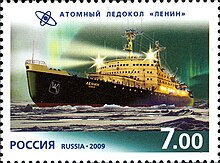Lenin (ship, 1959)
|
||||||||||||||||
|
||||||||||||||||
|
||||||||||||||||
|
||||||||||||||||
The atomic icebreaker Lenin ( Russian Ленин ) is the first atomic icebreaker in the world, and thus the first civilian nuclear-powered ship in the world. It is named after Lenin , one of the founders of the USSR .
The launch of Lenin took place on 5 December 1957 and the end of 1959 was put the ship into service. It was equipped with three nuclear reactors that drove the three propellers via four steam turbines , generators and electric motors .
The Lenin was decommissioned in 1989 because its outer shell had become too thin due to ice abrasion and has since been in the port of the atomic fleet for atomic icebreakers in Murmansk . It is being converted into a museum ship, the first part of which was opened in Murmansk in May 2009.
exhibition
Until January 10, 2014, the Lenin hosted an exhibition by Russian and Austrian artists as part of the fifth Moscow Biennale, who were invited by the Austrian Embassy in Moscow and the Lentos Art Museum Linz to deal with the atomic icebreaker. A free booklet was published in German, English and Russian for the Lenin Icebreaker exhibition .
Nuclear accidents
In February 1965 there was a loss of coolant accident . After the shutdown to replace the fuel elements, the coolant of the second reactor was removed, presumably through an oversight by the operator, before the fuel elements were removed. As a result, some fuel rods were melted or deformed by the heat of decomposition and the loss of cooling.
After this accident, only 94 of the fuel elements could be removed and handed over to the nuclear service ship Lepse . The remaining 125 remained in the reactor vessel together with the control rods . This was expanded as a unit, placed in a special container, solidified and initially stored for two years. The vessel was then sunk into the sea in the Ziwolka Bay off Novaya Zemlya in 1967.
The second accident on board the nuclear icebreaker Lenin occurred in 1967 when a leak occurred in the pipe system of the third reactor after it had been filled with new fuel rods. To localize the damage, it was necessary to open the biological shield of the reactor, consisting of concrete mixed with metal splinters, with sledge hammers . This led to further damage to the reactor installation. Upon rechecking, it was found that this made it impossible to repair the damage.
After the accident, the three OK-150 reactors with 90 MW each were replaced by two OK-900 reactors with 171 MW output until 1970. The first reactor OK-900 went into operation on April 22, 1970, the second reactor one day later. The repair and preparation for operation lasted until June 20th. The OK-900 reactor plant remained in operation until the icebreaker was decommissioned in 1989. The spent nuclear fuel was removed from the reactors in 1990.
See also
Web links
- A legacy of the Northern Fleet: pictures from the "Lenin" series with interior shots, ORF.at from September 15, 2013
Individual evidence
- ↑ http://orf.at/#/stories/2199037/ Murmansk: A Soviet fur seal and his northern sea, ORF.at from September 18, 2013.
- ↑ http://orf.at/stories/2198643/2198644/ Ghost ship with operational crew, ORF.at from September 18, 2013.
- ↑ The activists are in prison, the art protests in FAZ from October 31, 2013, page 27.


